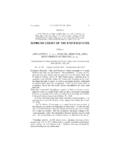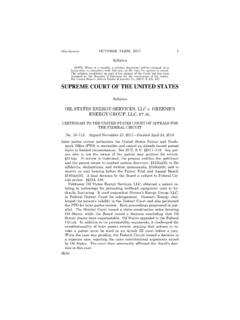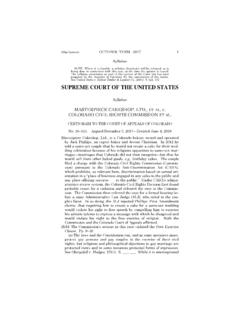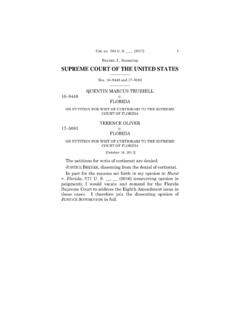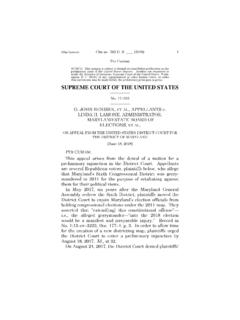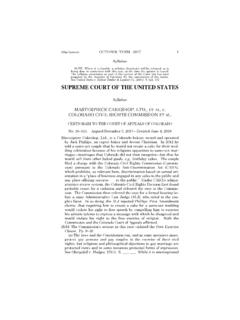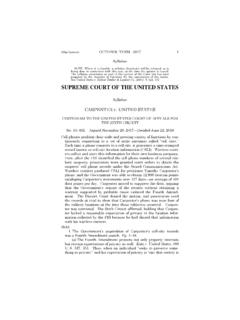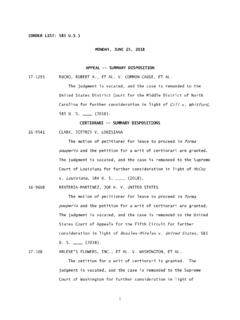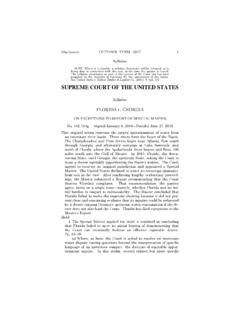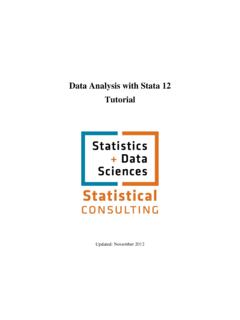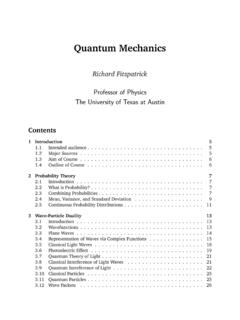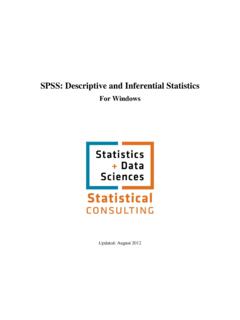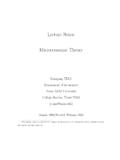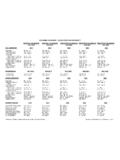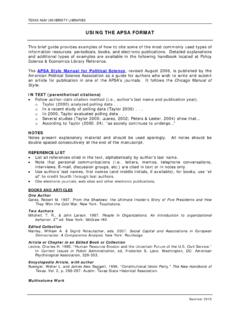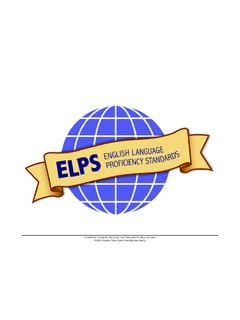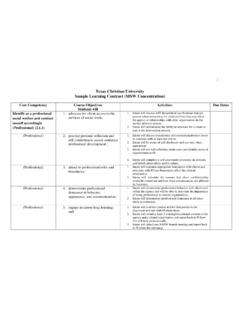Transcription of SUPREME COURT OF THE UNITED STATES
1 1 (Slip Opinion) OCTOBER TERM, 2015 Syllabus NOTE: Where it is feasible, a syllabus (headnote) will be released, as isbeing done in connection with this case, at the time the opinion is syllabus constitutes no part of the opinion of the COURT but has beenprepared by the Reporter of Decisions for the convenience of the reader. See UNITED STATES v. Detroit Timber & Lumber Co., 200 U. S. 321, 337. SUPREME COURT OF THE UNITED STATES Syllabus FISHER v. university OF texas AT AUSTIN ET AL. CERTIORARI TO THE UNITED STATES COURT OF APPEALS FOR THE FIFTH CIRCUIT No. 14 981. Argued December 9, 2015 Decided June 23, 2016 The university of texas at Austin ( university ) uses an undergraduate admissions system containing two components. First, as required by the State s Top Ten Percent Law, it offers admission to any students who graduate from a texas high school in the top 10% of their then fills the remainder of its incoming freshman class, some 25%,by combining an applicant s Academic Index the student s SATscore and high school academic performance with the applicant s Personal Achievement Index, a holistic review containing numerous factors, including race.
2 The university adopted its current admis-sions process in 2004, after a year-long-study of its admissions pro-cess undertaken in the wake of Grutter v. Bollinger, 539 U. S. 306, and Gratz v. Bollinger, 539 U. S. 244 led it to conclude that its priorrace-neutral system did not reach its goal of providing the education-al benefits of diversity to its undergraduate students. Petitioner Abigail Fisher, who was not in the top 10% of her high school class, was denied admission to the university s 2008 freshman class. She filed suit, alleging that the university s consideration ofrace as part of its holistic-review process disadvantaged her and oth-er Caucasian applicants, in violation of the Equal Protection District COURT entered summary judgment in the university s fa-vor, and the Fifth Circuit affirmed. This COURT vacated the judg-ment, Fisher v.
3 university of Tex. at Austin, 570 U. S. ___ (Fisher I),and remanded the case to the COURT of Appeals, so the university s program could be evaluated under the proper strict scrutiny stand-ard. On remand, the Fifth Circuit again affirmed the entry of sum-mary judgment for the university . Held: The race-conscious admissions program in use at the time of peti-tioner s application is lawful under the Equal Protection Clause. 2 FISHER v. university OF TEX. AT AUSTIN Syllabus Pp. 6 20.(a) Fisher I sets out three controlling principles relevant to as-sessing the constitutionality of a public university s affirmative ac-tion program. First, a university may not consider race unless theadmissions process can withstand strict scrutiny, , it must show that its purpose or interest is both constitutionally permissible andsubstantial, and that its use of the classification is necessary to ac-complish that purpose.
4 570 U. S., at ___. Second, the decision to pursue the educational benefits that flow from student body diversity is, in substantial measure, an academic judgment to which some, butnot complete, judicial deference is proper. Id., at ___. Third, when determining whether the use of race is narrowly tailored to achieve the university s permissible goals, the school bears the burden of demonstrating that available and workable race-neutral alterna-tives do not suffice. Id., at ___. Pp. 6 8.(b) The university s approach to admissions gives rise to an unusu-al consequence here. The component with the largest impact on peti-tioner s chances of admission was not the school s consideration of race under its holistic-review process but the Top Ten Percent Plan. Because petitioner did not challenge the percentage part of the plan, the record is devoid of evidence of its impact on diversity.
5 Remand for further factfinding would serve little purpose, however, because atthe time of petitioner s application, the current plan had been in ef-fect only three years and, in any event, the university lacked author-ity to alter the percentage plan, which was mandated by the texas Legislature. These circumstances refute any criticism that the Uni-versity did not make good faith efforts to comply with the law. The university , however, does have a continuing obligation to satisfy the strict scrutiny burden: by periodically reassessing the admission pro-gram s constitutionality, and efficacy, in light of the school s experi-ence and the data it has gathered since adopting its admissions plan,and by tailoring its approach to ensure that race plays no greater role than is necessary to meet its compelling interests. Pp. 8 11.(c) Drawing all reasonable inferences in her favor, petitioner has not shown by a preponderance of the evidence that she was deniedequal treatment at the time her application was rejected.
6 Pp. 11 19.(1) Petitioner claims that the university has not articulated itscompelling interest with sufficient clarity because it has failed tostate more precisely what level of minority enrollment would consti-tute a critical mass. However, the compelling interest that justifiesconsideration of race in college admissions is not an interest in enrol-ling a certain number of minority students, but an interest in obtain-ing the educational benefits that flow from student body diversity. Fisher I, 570 U. S., at ___. Since the university is prohibited from 3 Cite as: 579 U. S. ____ (2016) Syllabus seeking a particular number or quota of minority students, it cannot be faulted for failing to specify the particular level of minority en-rollment at which it believes the educational benefits of diversity willbe obtained.
7 On the other hand, asserting an interest in the educational benefitsof diversity writ large is insufficient. A university s goals cannot be elusory or amorphous they must be sufficiently measurable to per-mit judicial scrutiny of the policies adopted to reach them. The rec-ord here reveals that the university articulated concrete and precise goals , ending stereotypes, promoting cross-racial understand-ing, preparing students for an increasingly diverse workforce and society, and cultivating leaders with legitimacy in the eyes of thecitizenry that mirror the compelling interest this COURT has ap-proved in prior cases. It also gave a reasoned, principled explana-tion for its decision, id., at ___, in a 39-page proposal written after a year-long study revealed that its race-neutral policies and programsdid not meet its goals.
8 Pp. 11 13. (2) Petitioner also claims that the university need not consider race because it had already achieved critical mass by 2003 underthe Top Ten Percent Plan and race-neutral holistic review. The rec-ord, however, reveals that the university studied and deliberated for months, concluding that race-neutral programs had not achieved the university s diversity goals, a conclusion supported by significantstatistical and anecdotal evidence. Pp. 13 15.(3) Petitioner argues further that it was unnecessary to consider race because such consideration had only a minor impact on the number of minority students the school admitted. But the record shows that the consideration of race has had a meaningful, if still limited, effect on freshman class diversity. That race consciousness played a role in only a small portion of admissions decisions shouldbe a hallmark of narrow tailoring, not evidence of unconstitutionali-ty.
9 P. 15. (4) Finally, petitioner argues that there were numerous other race-neutral means to achieve the university s goals. However, as the record reveals, none of those alternatives was a workable means of attaining the university s educational goals, as of the time of her application. Pp. 15 19. 758 F. 3d 633, affirmed. KENNEDY, J., delivered the opinion of the COURT , in which GINSBURG, BREYER, and SOTOMAYOR, JJ., joined. THOMAS, J., filed a dissenting opinion. ALITO, J., filed a dissenting opinion, in which ROBERTS, C. J., and THOMAS, J., joined. KAGAN, J., took no part in the consideration or decision of the case. _____ _____ 1 Cite as: 579 U. S. ____ (2016) Opinion of the COURT NOTICE: This opinion is subject to formal revision before publication in thepreliminary print of the UNITED STATES Reports.
10 Readers are requested tonotify the Reporter of Decisions, SUPREME COURT of the UNITED STATES , Wash ington, D. C. 20543, of any typographical or other formal errors, in orderthat corrections may be made before the preliminary print goes to press. SUPREME COURT OF THE UNITED STATES No. 14 981 ABIGAIL NOEL FISHER, PETITIONER v. university OF texas AT AUSTIN, ET AL. ON WRIT OF CERTIORARI TO THE UNITED STATES COURT OF APPEALS FOR THE FIFTH CIRCUIT [June 23, 2016] JUSTICE KENNEDY delivered the opinion of the COURT . The COURT is asked once again to consider whether the race-conscious admissions program at the university of texas is lawful under the Equal Protection Clause. I The university of texas at Austin (or university ) reliesupon a complex system of admissions that has undergonesignificant evolution over the past two decades. Until 1996, the university made its admissions decisions pri marily based on a measure called Academic Index (or AI), which it calculated by combining an applicant sSAT score and academic performance in high school.
